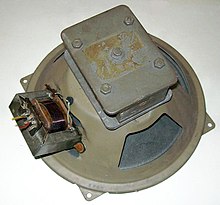|
Constant-voltage speaker system Constant-voltage speaker systems refer to networks of loudspeakers which are connected to an audio amplifier using step-up and step-down transformers to simplify impedance calculations and to minimize power loss over the speaker cables. They are more appropriately called high-voltage audio distribution systems.[1] The voltage is constant only in the sense that at full power, the voltage in the system does not depend on the number of speakers driven (as long the amplifier's maximum power is not exceeded).[2] Constant-voltage speaker systems are also commonly referred to as 25-, 70-, 70.7-, 100 or 210-volt speaker systems; distributed speaker systems; or high-impedance speaker systems. In Canada and the US, they are most commonly referred to as 70-volt speakers. In Europe, the 100 V system is the most widespread, with amplifier and speaker products being simply labeled with 100 V. OperationConstant-voltage speaker systems are analogous to electrical power transmission methods employed by electric utility companies to transmit electric power over long distances. Typically, an electric utility will step up the voltage of the power transmitted, which correspondingly reduces the current, hence reducing the power loss during transmission. The voltage is stepped down at the destination. Similarly, in a constant-voltage speaker system, the amplifier uses a transformer to step up the voltage of the audio signal to reduce power loss over the speaker cable, allowing more power to be transmitted over a given wire diameter. Each speaker in the system has a step-down transformer to reduce the voltage to a usable level. Loudspeaker connectionEach loudspeaker's step-down transformer can be designed for a single power level or it can have multiple taps, one of which is selected to match the desired power level to be applied to the loudspeaker. Transformers with various taps allow the installer to adjust the sound pressure level up or down at an individual loudspeaker. Purpose-built models are available that have the transformer contained within the loudspeaker enclosure. The loudspeaker step-down transformer primary is connected in parallel to the constant-voltage line.[3] Amplifier connectionConstant-voltage lines can be driven by a conventional amplifier with external step-up transformer, an amplifier with an internal step-up transformer or a high-voltage amplifier with transformerless output. External step-up transformerA general-purpose amplifier with typical low-impedance output is used. Its output is connected to the primary of an external step-up transformer. Special-purpose transformers can tailor the system design to the project's target power levels. Multiple amplifiers can be combined together via transformers to yield higher voltage and higher current capacity lines. For instance, three 70-volt amplifiers have been used to make a 210-volt line by connecting them to a special-purpose external output transformer that has three primaries and a single secondary.[4][failed verification] Internal step-up transformerAmplifiers with built-in 70-volt output transformers are available with low impedance and high impedance output connections, the latter typically labeled "25 V" and "70 V". These are robust, purpose-built amplifiers with many application-specific design features such as overcurrent protection and aggressive high-pass filtering for flyback voltage protection. Some models can be configured so that one channel drives one or two low impedance 8-ohm speakers while the other drives a constant-voltage string of speakers.[3] High voltage transformerlessWith advances in power semiconductors, it became possible to output high voltage directly from the output stage of the amplifier. For example, in 1967 Crown International introduced the DC300 amplifier, which is capable of directly driving 70-volt lines, as well as traditional speaker loads, thanks to its overall power[5] of 500W.[6] In 1987, Crown introduced the Macrotech 2400, capable of driving 100-volt lines directly.[3] Since then, further developments in high-power amplifier technology have widened the choices. Many manufacturers make amplifiers capable of direct connection to a high-impedance constant-voltage speaker line. High-voltage audio amplifiers have almost become a one chip solution. For example, National Semiconductor's LME49810[7] (and similar products LME49811[8] and LME49830[9]) can output 100 V peak to peak signals, but have relatively low current output, so a standard circuit includes a Darlington or FET discrete output stage. Higher power levelsHigh-voltage constant-voltage systems can be designed to use 140-, 200- and 210-volt lines, depending on the transformers selected and the amplifier connection topology. Such high voltage systems have been used in locations where small diameter wire is already in place, where long-distance wire runs are involved and at especially loud installations such as Daytona International Speedway[10] and the Indianapolis Motor Speedway prior to its redesign in 2003.[11] Safety considerations in such high voltages require speaker line installation within conduit in most of the world. 600 watt transformers are widely available for contractors needing high power loudspeakers in constant-voltage installations.[12] Special-purpose transformers capable of handling 1250 watts down as low as 50 Hz are available.[4] One problem with high power, high current transformers is that fewer can be used on a single constant-voltage line. Larger diameter speaker wire is recommended. Larger transformers needed for high power handling have reduced high-frequency response. AlternativesThe traditional alternative to constant-voltage speaker systems are low impedance speaker systems (commonly referred to as "8-ohm speaker systems" in spite of the fact that their impedance may not be 8 ohms), in which the amplifier and speaker are directly coupled without the use of transformers. The disadvantages relative to constant-voltage systems are that speaker cables need to be shorter or larger in diameter and that more amplifiers are needed if different listening levels are desired at different locations. Another alternative are powered speakers with an amplifier built into the speaker enclosure. Since the amplifier is at the same location as the speaker, the speaker requires only a line level audio signal as an input. Line level signals are typically around 1-2 volts, and can be transmitted over much smaller cable (typically 20-26 AWG). The main disadvantage of powered loudspeakers is that they have the additional requirement of requiring AC power, whereas passive speakers have no such requirement. AdvantagesThe main advantages of using a constant-voltage speaker system over a conventional low impedance speaker system are:
Disadvantages
References
External links |